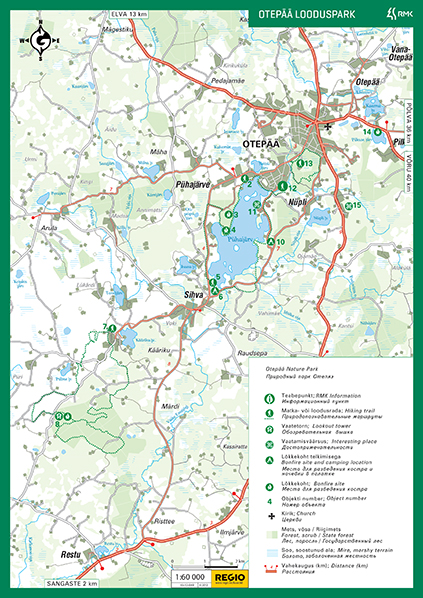Otepää Nature Park
Otepää Nature Park extends over a hilly and lake-rich area of 222 km² in the north-eastern part of Valga County, being the largest landscape protection area in Estonia.The treasures of the nature park are the diverse and unique landscapes that are characteristic to the uplands. The largest among the 65 lakes in the Nature Park area, Lake Pühajärv (290,7 ha) with its curvy shoreline and five wooded islands is considered to be the most beautiful lake in Estonia. Not far from Lake Pühajärv also the nature park's most significant ancient tree – the Pühajärve War Oak – can be found.
| Location | Valga County |
| Attractions | Hilly terrain, bodies of water, heath forests and fresh boreal forests, smaller rich fens, single protected natural objects (Pühajärve war oak and Trepimäe oak, Tsuura spruce, Märdi phellodendron, etc.) |
| Information | RMK Kiidjärve Nature Centre |
| Phone | +372 676 7122 |
| E-mail | info.kiidjarve@rmk.ee |
| Visitor management | Centre for State Forest Management in Estonia (RMK) |
| Protected Area Manager | Environmental Board of Estonia, phone +372 662 5999; info@keskkonnaamet.ee |
| More information | Otepää Nature Park |
| Visiting restrictions | See visiting restrictions here. |
| Additional information | The area is enlisted as a Natura 2000 site of birds and habitats. |
| Files | Hiking trails near lake Pühajärve brochure was published by Environmental Board in 2015. Download PDF. |
| Additional information | In Estonian nature, old explosive devices left from the war, still can be found. If you have found an object resembling an explosive device, leave it untouched, mark the location and immediately report the discovery to the emergency number 112. More information on the website of the Estonian Rescue Board. |
Click on the map to download it. Object No.7 on the map (Kekkose hiking trail) is not managed by RMK.
(The file is large, therefore the download takes a few minutes.)
(The file is large, therefore the download takes a few minutes.)
